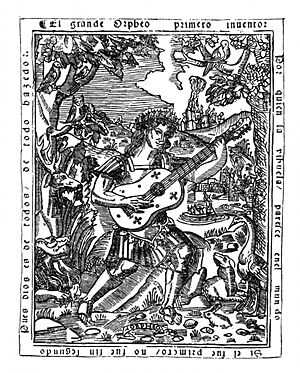Luis de Milán facts for kids
Luis de Milán (around 1500 – 1561) was a Spanish Renaissance composer. He played and wrote music for an instrument called the vihuela. He was also a writer about music.
The vihuela was a popular instrument in Spain and parts of Italy during the 1400s and 1500s. Luis de Milán was the first person ever to publish music specifically for the vihuela. He was also one of the first musicians to write down how fast or slow a piece of music should be played. These are called tempo indications.
Milán likely lived his whole life in Valencia, Spain. He probably worked for the local duke's court until about 1538. In 1535, he published his first book. It was a parlor game with music called El juego de mandar. The next year, he released his most important work.
Contents
El Maestro: A Music Book for Vihuela (1536)
Milán's famous book, Libro de música de vihuela de mano intitulado El Maestro, was printed in December 1536. He dedicated it to King John III of Portugal. The book also included six songs called villancicos in Portuguese. This suggests that Milán might have visited Portugal.
What is El Maestro?
El Maestro was the first collection of music for the vihuela ever published. It was made to help students learn the instrument. The music was arranged from easy to hard. This way, players could learn step by step.
The book has two main parts. One part is for the vihuela by itself. The other part is for a singer and the vihuela together. The book contains 72 pieces in total.
Types of Music in El Maestro
The instrumental part of the book has forty fantasías. These are like free-form musical ideas. It also includes six pavanas, which are slow, stately dances. There are also four tientos, another type of instrumental piece.
For the voice and vihuela part, there are twelve villancicos. These are Spanish folk-like songs. There are also four romances, which are narrative songs. Finally, there are six sonetos (sonnets). Most of the songs use Spanish words. However, the sonnets are in Italian. Half of the villancicos are in Portuguese.
Playing the Music
Many pieces in El Maestro need a lot of skill to play. But Milán also made it easier for some players. He included different ways to play certain parts. Some sections were even marked as optional.
Milán was careful when preparing his book. He gave clear instructions for tempo. For example, he wrote: ni muy apriessa ni muy a espacio sino con un compás bien mesurado. This means "neither too quickly nor too slowly, but with a moderate measure."
Later Works
Milán's last book was called El cortesano (1561). It was inspired by a famous Italian book, Il Cortegiano. Milán's book gives a fun and detailed look at life in the Valencian court. It does not contain any music. However, it is a valuable record from a musician of that time.
Lasting Impact
The music of Luis de Milán is still popular today. Many classical guitar players enjoy his pieces. This is because his music can be easily changed to fit the modern classical guitar.
Recordings
- Listen to music by Luis de Milán performed by Jordi Savall.
- You can listen online to "El Maestro" played by Edward Martin or by Jacob Heringman and Catherine King.
- In 2005, the group Capilla Flamenca recorded Dulcis Melancholia. This album includes two of Milán's Pavane pieces.
See also
 In Spanish: Luis de Milán para niños
In Spanish: Luis de Milán para niños


